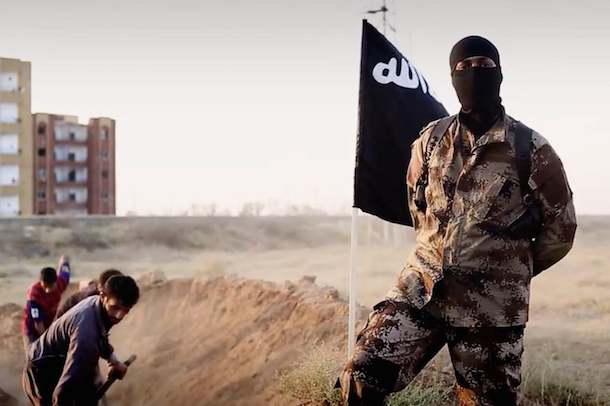
How America and the World Combats ISIS
“I have homegrown, violent extremist investigations in every single state,” FBI Director James Comey stated during the National Association of Attorneys General in March 2015. “We have people in various stages of radicalizing in all 50 states,” he added, stressing that the threat against America does not just include New York or Washington. Comey’s remarks underscore that the entire United States is facing an increasingly fluid and complex threat. Recent events prove his words are true.
Law enforcement, led by the FBI, have arrested at least 49 alleged Islamic State in Iraq and Syria (ISIS) supporters this year alone (excluding two terrorist deaths in Texas, and one in Massachusetts) according to CNN-conducted analysis on July 1. In separate incidents, authorities have arrested multiple individuals in West New York, New Jersey, only minutes from Manhattan, and in New York City itself, for allegedly conspiring to support or to join ISIS.
Intelligence agencies around the world, including those in the United States, are working hard to keep tabs on terrorists and sympathizers who desire to connect with ISIS or wage single attacks against their homeland. The CIA has even reorganized departments, teaming intelligence analysts, language and cultural experts, and computer specialists together in a combined effort to combat ISIS. The European Parliament has reportedly also engaged in greater intelligence sharing, targeted recruitment of Arabic-speaking linguists, and boosted cooperative anti-terrorism-related efforts with Middle Eastern countries.
So Close, But So Far Away
Terrorists do not have to travel to America to wage war; they only need to travel to the nearest diplomatic post. On March 15 and 16, 2015, the U.S. Embassy in Saudi Arabia shutdown consular services amid “heightened security concerns” for one week and asked its foreign nationals to travel if only absolutely necessary.
The previous day, the American Embassy in Riyadah divulged that it knew: “…as of early March, individuals associated with a terrorist organization could be targeting Western oil workers, possibly to include those U.S. citizens working for oil companies in the Eastern Province, for an attack(s) and/or kidnapping(s). There is no further information on the timing, target, location, or method of any planned attacks.”
This event was not the first time this year that a U.S. Embassy had been closed amid security concerns. In February 2015, Washington closed its embassy in Yemen and relocated its personnel because of “the uncertain security situation.”
ISIS’ Global Presence
The threat of ISIS or an ISIS-inspired attack against the homeland is not just a problem for the United States. It is a global issue which impacts all regions of the world. Events in Belgium, France, Tunisia, Australia, and other countries highlight this truly global threat. “Since the conflict began in 2011, more than 20,000 foreign fighters – at least 3,400 of whom are Westerns, have gone to Syria from more than 90 countries,” articulated James Clapper, Director of National Intelligence, before the Senate Armed Services Committee on February 26, 2015.
The nation’s top spy estimated that 180 Americans have been engaged in “various states of travel to Syria” and emphasized this number includes individuals who tried to travel to Syria and did not, those who were successful, those who died while fighting, and a “small number” who came back.
Clapper voiced that terrorists were not just returning to the United States. United Kingdom, for example, has been on heightened alert since a June 26 terrorist attack on a Tunisian resort left 38 civilians dead, including 30 Britons. London even conducted a mock terrorism drill involving an estimated 1,000 personnel in the Aldwych subway station. Metropolitan Police Commissioner, Sir Bernard Hogan-Howe, stated according to the Express that such training exercises are necessary “should the worst happen.” Hogan-Howe reiterated that this training exercise was not in response to any credible threat and that it had been planned for months. Earlier this month marked the ten-year anniversary of the London 7/7 bombings, where more than 700 were injured and 52 were killed when multiple bombs exploded on public transport and at underground stations.
Debate in the UK over immigration has recently become a point of contention. Mass migrations and inclusive communities have made the already difficult task of combatting terrorism more challenging. Mohammed Emwazi, identified now as “Jihad John,” an ISIS figurehead, and the man behind the black mask in multiple ISIS beheading videos, immigrated to the UK at an early age.
ISIS Recruits from East
Intelligence officials have made it clear that Westerners are joining ISIS, but what may be less known is that the terrorist organization continues to gain numbers from East Asia. China, for example, has its own challenges trying to limit individuals from connecting with ISIS. Wu Sike, Beijing’s special envoy to the Middle East, said according to reports in July 2014, that as many as 100 Chinese nationals may have joined the group, reported Reuters.

With 100 million Chinese nationals traveling abroad last year, Chinese officials have real concerns about some of these individuals linking with ISIS while overseas. In March 2015, Malay Minister Ahmad Zahid Hamidi, disclosed that 300 Chinese militants had used his country as a stopgap so that they could join ISIS. Like other countries, China also has been targeted by ISIS. On July 4, 2014, Abu Bakr al-Baghdadi, ISIS’ leader, released a video stating that the organization seeks to wage war against nations due to their treatment of Muslims. Of the twenty countries al-Baghdadi listed, Beijing was number one. ISIS likely has targeted China due to its treatment of Muslims living in the western China.
ISIS Goes Viral
While ISIS and other terrorist organizations still promote their message, ideology, and recruit members using plain word of mouth, the Internet has rapidly enabled terrorists to promote their message in an efficient and effective manner to anyone who has an Internet connection. It enables recruiters to easily interact with those who desire to join ISIS or for individuals to freely “educate” themselves using the deep Internet (i.e., chatrooms, forums, etc. which are not carried by everyday browsers). Top intelligence officials believe homegrown terrorists are “the most likely threat to the homeland” and the Internet is a major reason why. In testimony before the Senate Judiciary Committee in early July, Comey stated that the Internet has given terrorists “direct access into the United States.”
Social media sites like Twitter, Facebook, and Youtube, allow for spreading messages and videos to the masses. Posts by ISIS like the video of the burned Jordanian pilot certainly create a moral lift or demoralizing effect on its viewers. If individuals cannot travel to link up with ISIS, they have been directed via video to take matters into their own hands. Examples of ISIS-inspired attacks via the Internet include those which have occurred in Texas and the hatchet attacks in New York City and Australia. Most recently, law enforcement is investigating the attack against a Marine recruiting station in Tennessee as an act of terrorism.
Internet Turf War
The United States is expending all available technological resources to battle ISIS over the Internet. If they do not have the equipment, computer technicians and engineers simply build it. Cue Defense Advanced Research Projects Agency (DARPA), the foremost creative minds behind our military technology, and creator of the precursor to the Internet. “We need a technology to discover where [the deep Internet] content is and make it available for analysis,” Chris White, program coordinator at DARPA, told CNN. White said that a new DARPA computer program named MEMEX allows one to essentially view the Web site content of the deep Internet. Technology such as MEMEX is already active in the field.
The Obama administration has created and backed another technology—based method to combat terrorism and ISIS through the Center for Strategic Counterterrorism Communications (CSCC) located in the Department of State. This department would counter terrorist propaganda by communicating over Twitter in Arabic, Urdu, Punjabi, and Somali. The center wants to engage U.S. allies and community leaders who oppose ISIS believing that they may better relate to individuals who desire to join terrorist organizations. CSCC would synchronize more than 350 State Department Twitter accounts, embassies, and consulates, including those run by other defense departments, according to The New York Times.
China, for instance, has taken a slightly different approach to combat ISIS sympathizers. Like Washington, Beijing has stepped up efforts to combat terrorism, specifically targeting individuals who use the Internet for recruitment and disbursement of terror-related information. At the 2014 Shanghai Cooperation Organization Summit, in Dushanbe, Chinese President Xi Jingping stated that member states should devote their efforts to “combatting religious and Internet extremism.” Within weeks, Chinese lawmakers had drafted an amendment to the Criminal Law to include harsh consequences for taking part in terrorism and/or distributing terrorist-related information. Aside from combating ISIS over the Internet or harsher laws, Washington has bolstered its presence in Iraq to combat ISIS as hundreds of additional troops have become advisors to the Iraqi military. It remains unclear if these troops serving as “advisors” will be drawn into conflict as they continue to train the Iraqi military.
Finally…
While ISIS remains a threat to America and many countries around the world, particularly at diplomatic posts in foreign countries, ISIS-inspired individuals acting alone represent perhaps the greatest challenge for law enforcement. Internet connections provide anyone access to information, Web sites, or chatrooms, which may aid in carrying out attacks. The United States and other countries have therein developed new Internet-based strategies to dispel terrorist propaganda and have created harsher laws to deter potential terrorists. As the U.S. budget to combat ISIS approaches $3 billion dollars, these countermeasures reflect that terrorism has once again become a major focal point, not only for the United States, but for the world.
